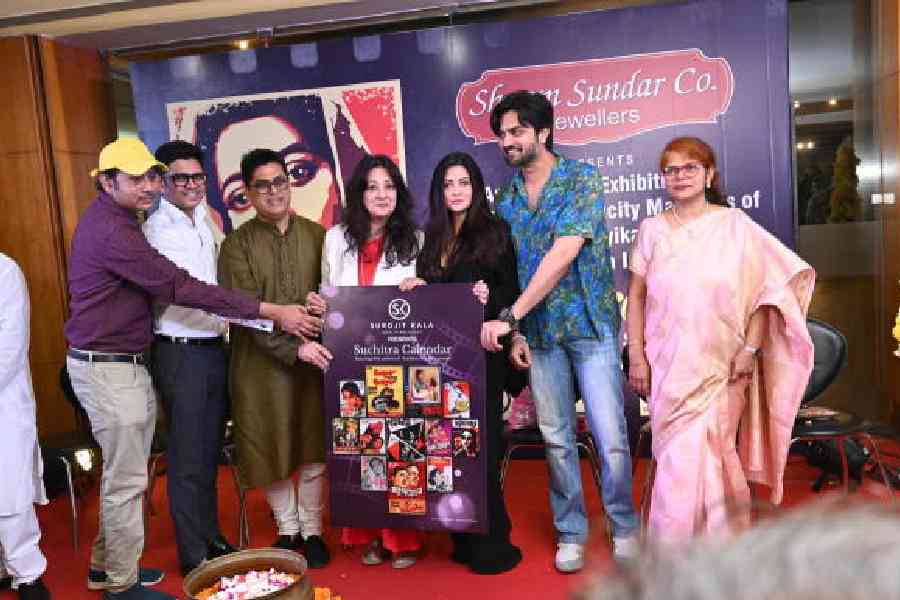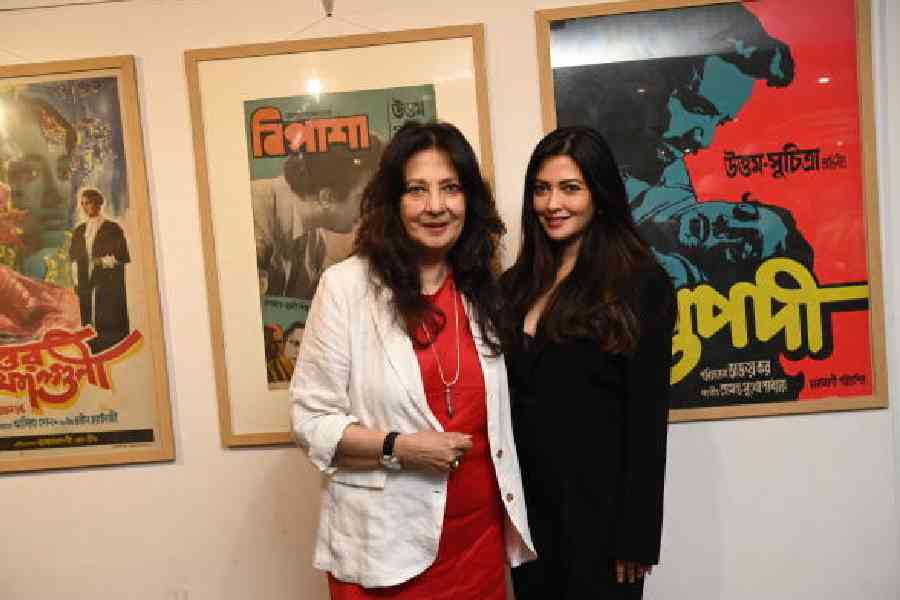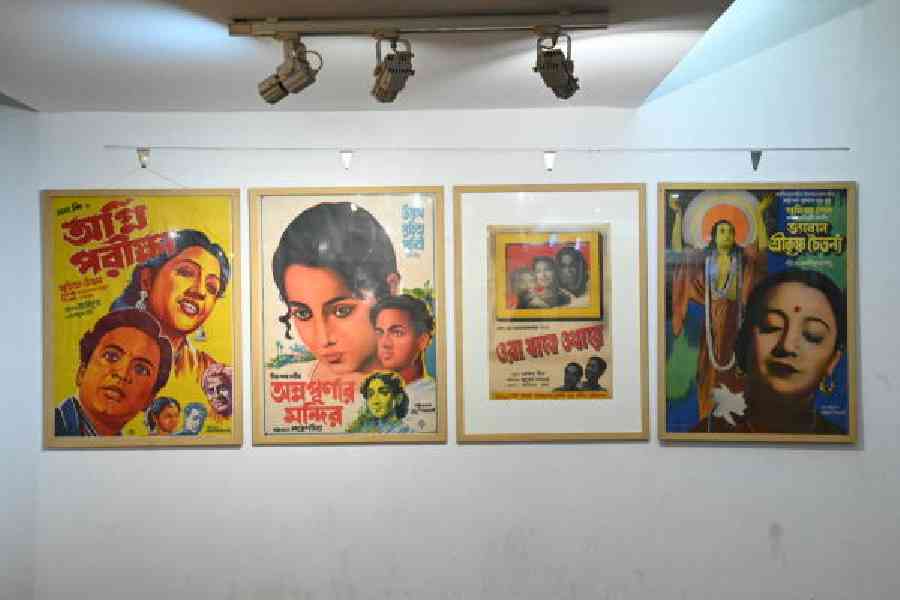What is common to the posters of the following Uttam Kumar-Suchitra Sen films — Agnipariksha (1954), Saapmochan (1955), Ekti Raat (1956), Sagarika (1956), Rajlaksmi o Srikanta (1958) and Indrani (1958)? All of them have Suchitra Sen’s name ahead of Uttam Kumar’s in the credits.
The posters were among those on view at an exhibition being held in tribute to Suchitra Sen in her birth anniversary week recently at ICCR.
The heroine’s name coming ahead of the hero’s continues to be a rare sight in film publicity to this day. According to contemporary film magazine reports, Suchitra Sen had objected to Uttam Kumar’s name always preceding hers on the posters of their films. Uttam Kumar, coming to hear of her objection, had apparently agreed. So much so that even Harano Sur that Uttam Kumar himself had produced in 1957 has Suchitra’s name above his in the poster.

A calendar featuring Suchitra Sen film posters being released by Moonmoon Sen (centre) along with (from left) archivist Sudipta Chanda, project sponsor Surajit Kala, Rupak Saha of Shyam Sundar Co, Riya Sen, Shivam Tewari and ICCR zonal head Minakshi Mishra
But even if this anecdote is true, the instruction could not have been set in stone. Posters of several other films at the exhibition — Annapurnar Mandir (1954), Sabar Upore (1955), Shilpi (1956), Jibon Trishna (1957), Suryatoran (1958), Chaoa Paoa (1959), Kamallata (1969), Nabarag (1971), Har Mana Har (1972), Alo Amar Alo (1972) — have Uttam Kumar leading the cast.
Some films like Pathe Holo Deri (1957) and the blockbuster Saptapadi (1961) curiously follow different orders in two separate posters, both of which were exhibited.
The exhibition was inaugurated by the screen legend’s daughter Moon Moon Sen, who was joined by her younger daughter Riya and son-in-law Shivam Tewari. “This is the first time that such an exhibition is being held on my mother. There is nothing in Calcutta to honour her name, which is all right. We don’t need statues or anything. This is a collection accumulated over 20 years (by archivist Sudipta Chanda). It’s the first time I have come somewhere on her birthday. But there is so much love and respect in this endeavour that I thought my family and I needed to come,” she said. Riya said she had come “for Amma”, as she addressed her grandmother.
A wall calendar, featuring some of the posters and printed at the initiative of Surojit Kala, was also launched at the event.
The 46 posters reveal a lot about trends in the communication strategy of the time. One saw how the story writers were named on the posters in case they were big names like Tarashankar Bandyopadhyay (Saptapadi, Bipasha, Fariyad) or Saratchandra Chattopadhyay (Grihadaha, Rajlaksmi o Srikanta), Banaphool (Ekti Raat) or Dr Nihar Ranjan Gupta (Uttar Falguni). A notable omission among the posters in this regard at the exhibition is Devdas. But Chanda, whose collection the exhibition largely draws upon, explained to t2 that the predominant poster of the 1955 Hindi film features Dilip Kumar alone while in another, Suchitra is hardly recognisable in the illustration, so they were not included in his collection.
The poster of Bhagaban Srikrishna Chaitanya, a film early in her career in which Suchitra played Bishnupriya, announces: ‘Berlin cholochchitro utsab-ey proshongshito (praised at Berlin Film Festival)’. A Bengali film travelling to a European film festival must have been a major event in those days. Incidentally, Suchitra was the first Indian actress to win an award at an international film festival with Saat Paake Badha (The Marriage Circle) winning the Silver Prize for Best Actress in 1963 in Moscow.

Moonmoon Sen with younger daughter Riya at the poster exhibition at ICCR
The Sagarika poster even carries a message from the lead pair: “Pronoy-modhur bhumikay amader jugol obhinoyer pothe Sagarika smaraniyo hoye roilo (In our acting journey as a duo in romantic roles, Sagarika remains memorable)”.
Another point to note is how the majority of the posters were printed outside Calcutta. If the Agnipariksha posters were printed at Litho Press in Bombay, the Mejobou posters came from Prasad Process Ltd, Madras while the Sagarika poster credited Dinakar Litho Printers, Vijaywada. Only a few, like Subharatri and Pathe Holo Deri, were printed in Calcutta — at Jayshree Printers, 22 Weston Street, Calcutta 13 and Gujrat Press, Calcutta 1 respectively.
The posters are a throwback to the pre-digital era when manual skill was the mainstay of designers. Some of the posters like Jibon Trishna, Hospital and Chaoa Paoa feature cutouts of black-and-white photographs of the lead pair around which the title and other elements have been painted in bright colours. Most were completely hand-painted while a few were a combination of both. Some featured striking typography, like the effect of flames in the title of Agnipariksha or the sharp angular look of the letters in Grihodaho, matching the geometrical shapes used in the poster. “Mind you, those hand-painted letters were the artist’s creation and were unique to the poster, unlike the fonts that designers get to choose today from sets stored in the computer,” said Gautam Barat, who has produced the publicity material for over 500 films, including 200-plus Prosenjit potboilers, and who grew up seeing his father Ratan Barat design posters and banners too.
“In those days, there was no scope to reduce or enlarge a picture while preparing a poster or a banner. So the photographs had to be printed in exactly the size in which they would be pasted in the artwork which would be sent for printing,” he recalls, walking up to the poster of Harano Sur. “This was drawn by my father,” he recalled.
Some of the posters in the exhibition, Barat reflected, might have been created after the film’s release. “In those days, a film reached the hall more than once. There were re-releases too, especially in the districts, perhaps after a gap of a couple of years. Posters would be needed even then for publicity,” he said. Pointing to the Sagarika poster, he recalled that its original release poster was in light blue and black-and-white. “I had seen that on the wall at the distributor’s office.”
Chanda said he had been collecting posters since 2000. “I started just after passing out of school on seeing men smearing glue on the backs of posters in front of Purna cinema and persuaded them to part with one. They directed me to the film distributor’s office for more. The film was The Great Gambler and that led me to collect posters of Amitabh Bachchan and then R.D. Burman, Kishore Kumar and Uttam Kumar films. Two years ago, I thought of focusing on Suchitra Sen. Of the 46 on view here, the toughest and most expensive to acquire was the poster of Aandhi, as the film was banned by the Election Commission after it released during the Emergency period and the government did not allow its publicity. I got it from a Bombay dealer,” Chanda said.
He met Moon Moon Sen by chance at an event and shared his plan. She gave him word right away that she would attend the event whenever his collection would be ready. “She suggested that her mother’s birthday would be a suitable occasion for the exhibition,” Chanda said.

Posters of some films where Suchitra Sen’s name appears above that of the male lead
He gifted her copies of the only vinyl record of Suchitra Sen’s songs. The 78rpm record, brought out by Megaphone, featured Bone noy aj mone hoy and Amar notun ganer nimontrone, set to tune by Robin Chatterjee with lyrics by Gouriprasanna Majumdar.
The record was part of the display, which also featured film booklets, magazines with Sen on the cover and print advertisements done by her from the collection of Aryan Souvik Banerjee.










